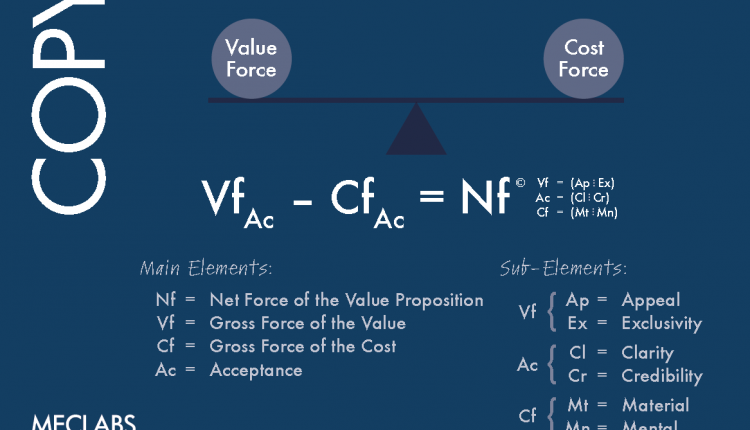When writing copy for promotions, content and advertising, many writers tend to be pulled between two possible directions: creativity on one side, and communication on the other.
How can I be creative and still effectively communicate the ideas I have?
Think like the customer
Creativity and communication are not the two opposing forces in the customer’s mind. The customer is weighing these two decisions:
- What is the value of this?
- How much will it cost me?
“Essentially the prospect, even if at a subconscious level, engages in elementary math: VfAc – CfAc, which is to say, they subtract the perceived cost force from the perceived value force,” said Flint McGlaughlin, Managing Director, MECLABS, parent company of MarketingExperiments.
This idea is illustrated in the heuristic below to help you see the net force of the value proposition:
You can dive deeper into the above heuristic in the MECLABS Value Proposition Development Course.
In this MarketingExperiments Blog post, we’ll take a look at two key copy elements – one very close to an actual purchase and another much farther up the funnel – and see what value and cost factors the customer might be considering.
Key Copy Element #1. Button copy
“Select Lodging” vs. “See All Rentals”
The button copy on the right achieved a 427% higher clickthrough rate than the button copy on the left.
This was not a single-factor test; other elements were changed on the landing pages that likely affected conversion rate, as well. You can see those in the full MarketingSherpa webinar replay of “Web Optimization: How one company implements an entire testing strategy every day.”
But, this is still a good example of weighing value and cost.
“Select Lodging” subtly implies more cost. The language puts the monkey on the customer’s back. Now, the prospective customer has to take the time to look through different options. Cost is about much more than just money. In this case, the cost is time (a form of mental cost). Of course, this button also implies the cost of actually purchasing the lodging (a form of material cost).
On the flipside, “See All Rentals” implies more value. Nothing is asked of the prospective customer. Instead, there is an offer to the prospective customer. Essentially, the copy conveys there are many rentals for the customer to view.
Key Copy Element #2. Content headlines
The cost and value balance is clearest in button copy. At that very point in time, you’re forcing a decision from the prospect – to click or not.
But with content headlines, it can be much easier to overlook the cost and value consideration and instead, focus solely on being clever or just summing up the article.
Make no mistake, there is still a cost factor consideration in a headline you use in your content marketing. If you look at the heuristic in the graphic above, this is a cost factor we would refer to as “mental.” The cost in this case is the time it takes to read the article and suck the reader away from their work.
As an example, here is headline for the most visited MarketingSherpa blog post of 2013:
How to Write a Competitive Analysis (with 3 free templates)
Here is how we tried to optimize the value of the headline with appeal and clarity:
“How to” has a high amount of appeal in content. There are really only two things prospects look for in content. One of those is help overcoming a problem, obstacle, pain point or whatever you would like to call it. Showing them “how to” do something appeals to that desire.
Of course, if the reader doesn’t really believe they will be receiving that “how-to” information, the value of that appeal is limited. In this case, coming from a reliable source, MarketingSherpa, provides the necessary credibility.
“3 free templates” provides clarity, clearly showing what exactly they will gain if they click on the headline in a Twitter feed or simply continue to read the blog post.
Next time you’re writing a piece of copy, ask yourself:
- What possible costs will prospective customers see in what I’m writing?
- What possible value will they deduce from what I’m writing?
Then, use the elements in the above graphic – such as appeal and clarity – to increase the value while decreasing the cost for the reader.
You may also like
The Web as a Living Laboratory e-book [Download a complimentary copy]
Copywriting: Is your landing page missing the ‘why’ factor? [More from the blogs]
Copywriting: Do you take your prospects on a journey? [More from the blogs]





Prominent headlines to the content draw immense attention and curiosity to read about the topic. So being a reader, I would prefer reading the page if the headline is attractive enough. I am familiar with one such organization that provides unique and concise contents named as Precise-English.